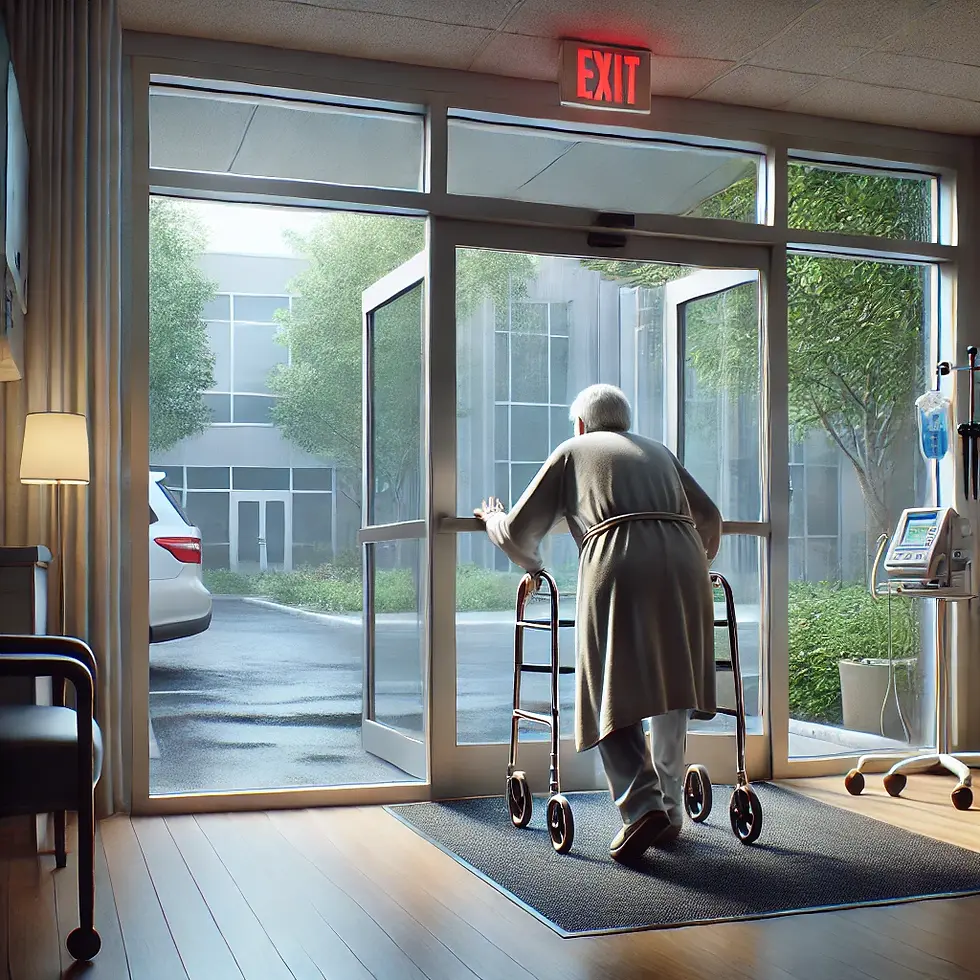Preventing Elopement: 10 Proactive Steps to Protect Residents and Ensure Facility Safety
- Bilquis Ali

- Sep 20, 2024
- 4 min read

I remember vividly stepping into my role as the Administrator of a Personal Care Home with over 100 residents.
The facility had just transitioned from assisted living, and with it came new challenges.
One of my greatest fears was dealing with a fire or an elopement.
Well, guess what?
My first night on the job, the smoke alarm went off for hours.
We couldn't find the source, and even after the fire department came and cleared it, it was just a sensor issue—but what a way to start!
Just a week later, someone came into the building and told me there was a man walking in the street.
My heart dropped, and I sighed, thinking, "WTH!"
Sure enough, he was one of ours.
Thankfully, we got him back safely, but that experience was an eye-opener.
Coming from a skilled nursing setting to a Personal Care Home was a shift.
In skilled nursing, residents are under stricter supervision, while in PCH, many can come and go as long as they sign out.
This resident was independent but clearly not appropriate for this setting, which is why I’m sharing this story.
My fears became a reality, but we were fortunate to avoid a negative outcome.
However, lack of preparation could lead to serious consequences.
Here’s how we can safeguard residents and train our team on how to respond if a resident exits the facility:
1. Complete a Thorough Admission and Elopement Risk Assessment
Conduct an in-depth elopement assessment on admission. If a resident is at risk, follow your facility’s policies.
Ensure orders include the location of the WanderGuard, and have staff check and sign off every shift.
Don’t forget to update the care plan and add a current picture.
2. Run Monthly Elopement Drills
Conduct drills on each shift to prepare staff.
This helps the team respond appropriately during an actual elopement and reduces panic in those critical moments.
Make sure communication tools like walkie-talkies or cell phones are part of these drills to streamline the response process.
3. Document Staff Response
After each drill or incident, document how the staff responded.
Are there areas for improvement? Address them immediately and consider retraining if necessary.
4. Review Quarterly at Care Plan Meetings
Continually assess if the resident is still at risk for elopement during quarterly care plan meetings.
If they are no longer at risk, document this, update the care plan, and discontinue the order. Ensure the family is in agreement.
5. Update Resident Photos Regularly
A resident’s appearance may change over time, and outdated photos can hinder the search process.
Make sure to keep these pictures current so staff can easily identify the resident.
6. Consider External Factors: Weather and Environment
Seasonal Changes: The weather can play a significant role in the severity of an elopement.
In winter, the cold can be life-threatening if a resident is exposed to it for too long, while in summer, heatstroke is a real risk.
During your drills, simulate scenarios for different seasons and ensure staff knows how to handle situations in extreme weather conditions.
Surrounding Hazards: What’s near your facility? Are there staff cars in the parking lot?
Imagine the tragic scenario of a resident getting into an unlocked car during a heatwave or cold spell—this could lead to a devastating outcome.
Always remind staff to lock their cars and keep keys out of sight.
7. Environmental Dangers: Public Transport or Nearby Exits
Bus Stops: Is there public transportation nearby? If a resident wanders off, could they get on a bus?
This presents an added layer of risk that we can’t ignore.
If there are bus stops nearby, educate your team to monitor these locations during drills and ensure they are part of your elopement response plan.
Facility Exits: Check the facility’s exits. Are there any areas where residents can slip out unnoticed? Make sure exit doors are secure and alarmed.
This may also mean walking the perimeter of your building during drills to identify potential vulnerabilities.
8. Equip Your Team with Communication Tools
In the event of an elopement, quick and clear communication is crucial.
Ensure that your drills include the use of equipment like walkie-talkies or cell phones.
Each staff member involved in the response should be equipped with a communication device, so there's no delay in relaying information about the resident's last known location or status.
9. Involve Families and Keep Them Updated
Clear communication with families is vital.
They should be aware of any changes in their loved one's care plan, elopement risk, or cognitive status.
Families can also provide valuable insights into behavioral changes that might increase the risk of wandering.
10. Involve Your Social Worker
Ensure your social worker is actively involved in monitoring residents who are at risk for elopement.
Regular BIMS assessments can help identify cognitive decline, which is often a trigger for wandering behavior.
Have your social worker keep these assessments up to date and collaborate with the care team to make adjustments to the resident’s care plan as needed.



I hadn’t thought of this. Thank you for keeping me on my toes and aware of varying incidents that may occur. The SNF and ALF are two different worlds.